Okay, So I’m just going to come out and say it. Size matters, we all know it. But how to find the right size can be a bit mysterious and dangerous if not done right.
“My appliance package comes with a blower, will it work?”
“Does actual size affect CFM?”
“My contractor says we have a CFM cap…?”
In this article, we’ll cover:
- How to calculate the proper blower size (CFM).
- Can a blower be oversized and move too much air?
- Getting the size right.
- Zoning laws and CFM caps.
- Bonus: Make-up air.
How small is too small? How big is too big? Calculating the Proper Blower Size.
If you open a search on calculating the needed CFM for your kitchen you can spend hours reading a vast number of ways to get an answer. And it is true three lefts do make a right 1st.. 2nd… round the corner, yeah you got it. But so does a right. It turns out there is a simple rule of thumb to get your answer.
Formula
Total burner Max BTU / 100 = Total CFM needed
Example
Burner 1-3 7,500btu each
Burner 4 10,000 btu
Burner 5 20,000 btu
Total burner Max BTU 52,500 / 100 = 525 needed CFM
Now that you’ve calculated how large of a blower/insert you need there are a couple of additional things you’ll want to know.
Going bigger doesn’t mean better.
It’s like that time when you fired up the old wood chipper and buzzed through a dozen Krispy Kreme’s. Just in time to have the family find you layed up in the fetal position when they got home. It wasn’t a good idea. And using too big of a blower isn’t either. The reason is gas, seriously when you have too big of a blower you create a gas issue.

Carbon Monoxide
When you cook Carbon Monoxide is released along with steam, smoke, and food smells. So you turn on your Range Hood. In this example, you’ve decided to install the Binford 6100 hurricane fan. With suction capabilities only second to your Kirby vacuum. The problem the 6100 creates, among others, is that the blower is pulling the lighter gas, Oxygen at a really high rate. Leaving the heavier gas, Carbon Monoxide (CO). Creating an imbalance and a concentration of CO. Too much CO, undetected and you go from Tool Time to Sleeping Beauty without even knowing it. All that to say in a serious tone this is not something you want to do or have happen to you or your loved ones.
Getting the size right and Zoning Laws
To get the size right it’s simple, use the calculation above, and don’t go too far above it. In most applications, a 550 CFM insert/blower is adequate and will handle whatever you can cook up.
Zoning and association rules and or laws may play into your calculations as well. So check with your Contractor, HVAC specialist, or Municipality to see if there are any restrictions. If there are the typical cap is 400CFM.
But wait you say. “I have a large commercial range and the calculation says I need 1,100CFM”?
When there is a large delta like in this case 1,100 – 400 = 700CFM over the limit The use of a makeup air system is required, to make up the difference and prevent the issue described above.
What is Makeup Air?
Makeup air units now come in many forms and types. Ranging from a stand-alone duct that is triggered to open when the range hood is turned on. To a more integrated option that has a makeup air feature built in. Like a Furnace or ERV/HRV unit.
Conclusion
Sourcing the right size Insert/blower doesn’t have to be complicated. By using the calculation above you will know exactly what you need. Or leave it to a trusted professional. Blue Fig Artisan Can help make all the calculations and source the perfect insert for your custom wood Range Hood, ensuring the proper fit and finish every time.



